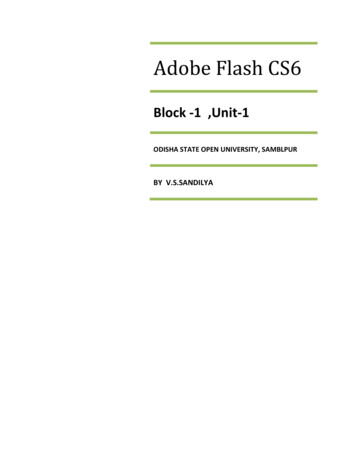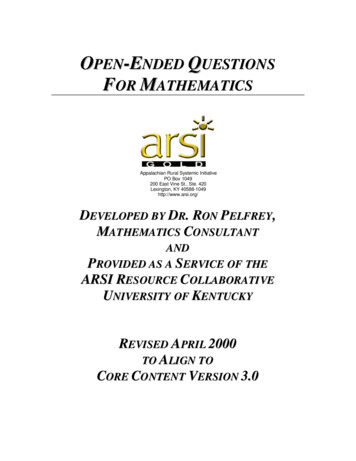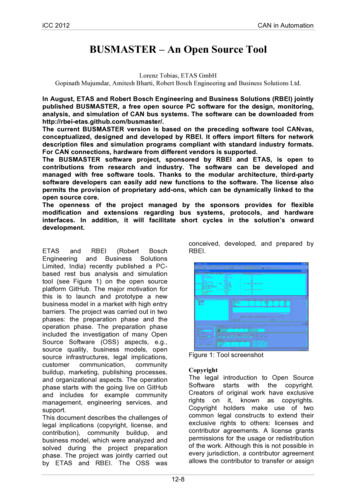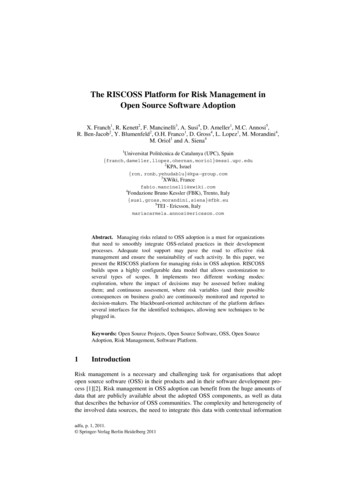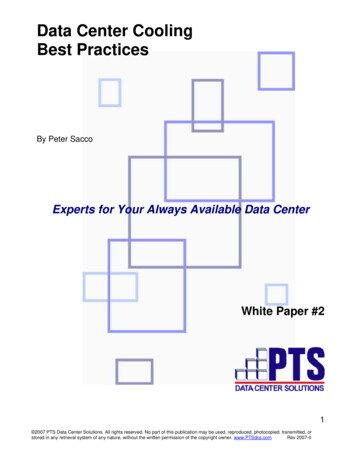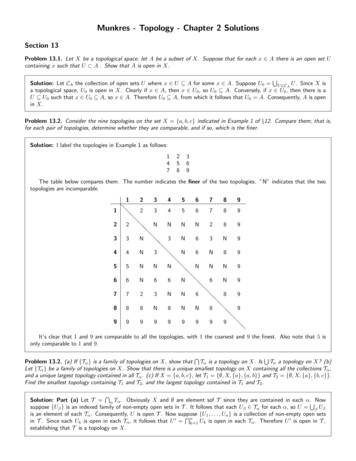Transcription
“How to Get an Open Shot”: Analyzing Team Movement inBasketball using Tracking DataPatrick Lucey, Alina Bialkowski, Peter Carr, Yisong Yue and Iain MatthewsDisney Research, Pittsburgh, PA, USA, 15213Email: {patrick.lucey, alina.bialkowski, peter.carr, yisong.yue, iainm}@disneyresearch.comAbstractIn this paper, we use ball and player tracking data from STATS SportsVU from the 2012-2013 NBAseason to analyze offensive and defensive formations of teams. We move beyond current analysis thatuses only play-by-play event-driven statistics (i.e., rebounds, shots) and look at the spatiotemporalchanges in a team’s formation. A major concern, which also gives a clue to unlocking this problem, isthat of permutations caused by the constant movement and interchanging of positions by players. In thispaper, we use a method that represents a team via “role” which is immune to the problem ofpermutations. We demonstrate the utility of our approach by analyzing all the plays that resulted in a 3point shot attempt in the 2012-2013 NBA season. We analyzed close to 20,000 shots and found thatwhen a player is “open” the shooting percentage is around 40%, compared to a “pressured” shot whichis close to 32%. There is nothing groundbreaking behind this finding (i.e., putting more defensivepressure on the shooter reduces shooting percentages) but finding how teams get shooters open is. Using ourmethod, we show that the amount of defensive role-swaps are predictive of getting an open-shot andthis measure can be used to measure the defensive effectiveness of a team. Additionally, our rolerepresentation allows for large-scale retrieval of plays by using the tracking data as the input query ratherthan a text label - this “video Google” approach allows for quick and accurate play retrieval.1 IntroductionA central theme in Dean Oliver’s book Basketball on Paper [1], is to “understand the team first and its players second.becauseit is the team that wins and loses, not individuals.”. Traditionally, team statistics such as offensive and defensive efficiencyratings, have been estimated from event-driven play-by-play data (e.g., shooting percentages, rebounds, turnoversetc.). While these team ratings have been used to good effect, the sparse nature of the play-by-play data means thatthese statistics only tell a partial story of what is occurring in a game (i.e., it can tell us what is happening, but notwhere and how). However, with the recent full deployment of optical tracking systems in the NBA using STATSSportsVU [2], a better and deeper story of have teams operate can be obtained because the ball and all players aretracked at 25 frames-per-second.Many recent works have used the STATS SportsVU data for improved analysis. Maheswaran et al., [3] used the datato investigate the optimal placement of players to obtain a rebound. Goldsberry [4] used the data to rank the bestshooters in the NBA using “CourtVision”, and more recently used it to rank individual defenders [5]. Maymin [6]used the data to explore burst locations on the court where players tend to accelerate, while Wiens et al., [7] lookedat which situations teams should go for an offensive rebound or not. Although interesting, none of these workshave focused on using the data to describe how teams operate as a unit. This is because tracking data is highlycomplex with players randomly moving resulting in an infinite number of possible permutations, makingcomparisons impossible. As Phil Jackson notes in his recent book Eleven Rings [14] “basketball is a dynamic game of chessin which all pieces are in motion.”, but it is through this dynamic motion that space and scoring chances are created. Inthis paper, we present a method which can normalize against the vast number of possible permutations by enforcinga role-representation. To show the utility of our approach, we analyze all the 3-second plays leading up to everythree-point attempt in the 2012-2013 NBA season and show that how a team’s defensive formation moves ispredictive of whether or not they give up a open shot or not.Based on the STATS SportsVU tracking data for the 2012-13 NBA season, we define an “open” shot as one inwhich the defender closest to the shooter is at least 6 feet away at the time of release (Section 2). We then build onour recent work in team analysis [8-11], and automatically infer the position or “role” (e.g., point-guard, center,power-forward etc.) that each player is fulfilling at every time instant (Section 3). Using both the tracking data androle assignments, we identify indicative factors of a shooter getting open for a three-point shot (Section 4). Finally,we show role information is critical for efficient, accurate and intuitive retrieval of similar plays (Section 5). Weapplied our techniques to the STATS SportsVU tracking data from the recent 2012-13 NBA season, and analyzedclose to 20,000 spatiotemporal sequences of three-point attempts.20142014 ResearchResearch PaperPaper CompetitionCompetitionPresented by:
0.450.450.40.40If a defender is more than 9ft awayshooting percentage is over 43%0.430.430.420.42If a defender is more than 6ft awayshooting percentage 40%0.410.41If a defender is closer than6ft at release shootingpercentage is 32%0.350.353 Point Shooting Percentage3 Point Shooting Percentage0.440.440.40.400.390.390.300.3If a defender is closer than 7.5 ft0.6-1.0 secs before release,shooting percentage drops to 29.2%0.250.250.200.20.150.15If a defender is closer than 6ft,0.6 secs before release shootingpercentage drops to 26.6%0.100.10.380.38Average rest Defender Distance Release Point (feet)(a)99000 secs0.6 secs1.0 secs0022610121444688101214Nearest Defender Distance Release Point (feet)(b)1616Figure 1. (a) As the distance of the nearest defender to the shooter increases, so does the 3-point shooting percentage. Whenthe defender is more than 6 feet away, the shooting percentage is 40%, and increases to over 43% when the defender is morethan 9 feet away at the release point. (b) Conversely, when the defender is closer to the defender the shooting percentagedrops. When a defender is within 6 feet, the shooting percentage is approximately 32.5%. However, when a defender iswithin 6 feet 0.6 seconds before the shot it drops to 26.6%.2 “Open” vs “Pressured” ShotsA recent study by Weil [13] showed that there was a strong relationship between field-goal shooting percentage anddefender proximity (i.e., further a defender was away, the higher the shooting percentage was), where he used over60 games of STATS SportsVU tracking data. In our work, we used an order of magnitude more games (600) across13 NBA teams which had the system installed in their arenas and analyzed the 3-second segment of play whichoccurred before the release-point of each attempt (we chose 3 seconds because in [16] it is noted that this is theoptimal time for a player to get open). Overall, we analyzed 19,386 three-point attempts from 13 different teams andthe shooting average for the shots analyzed was 36.7%.In Figure 1(a), we can see how the shooting average varies as the distance to the nearest defender increases specifically we can see that when a defender is 6 or more feet away, the shooting percentage hovers above 40%while it peaks to over 43% when a defender is more than 9 feet away at the release point of the shot. Conversely inFigure 1(b), we see that when a defender is within 6 feet of the shooter at the time of release, the shootingpercentage drops down to 32%. It drops even further when we look back at where the defender before the releasepoint. For example, it drops to 29.2% when a defender is within 7.5 feet 0.6 to 1 second prior to the release point,and further drops to 26.6% when a defender is within 6 feet 0.6 seconds prior to the shot release. Even thoughthese findings are interesting, there is nothing really compelling about them as it reinforces the conventional wisdomthat putting pressure on the shooter will reduce their shooting percentage. However, finding the ways teams get shootersopen in interesting. Before doing this, we first have to define what an “open” and “pressured” shot is. Looking at theblack curve of Figure 1(b), there seems to be a knee-point occurring at 6 feet which suggests a good threshold. Fromthis, we define an “open” shot as having a defender at least 6 feet away from the shooter and a “pressured” shot ashaving a defender at least 6 feet from the shooter at the time of release. Although the positional data does not giveus the context necessary to be definitive (i.e., we don’t know if the defender has his arm up or whether he isjumping?), but based on the volume of data we have analyzed it suggests that this is a reasonable approximation.Table 1 shows the offensive and defensive three-point shooting percentages of each team. Offensively (Table 1(a)),the Golden State Warriors have the best 3 point shooting percentage, averaging 42.13% while the MinnesotaTimberwolves are the worst shooting team with 30.08%. The Warriors also shoot very well under pressure with onlya difference of 2.90% between their “open” and “pressured” attempts. Apart from the Philadelphia 76‘ers, the rangein difference between “open” and “pressured” shots varies considerably from 3-11% (Cleveland shoot over 40%when open but 30% when they are pressured). A similar trend is found when analyzing the defense of each team(Table 1(b)) where the shooting percentage varies from 2% to under 15% (teams playing the Timberwolves shootover 40% when open but around 27.5% when under pressure - with more than half the shots being open theywould be well advised to put more pressure on the opposition shooters). In terms of the number of open shotsteams get, San Antonio get more than 60% of their 3-point attempts open while Toronto get less than 40%.Defensively, the Orlando Magic give up more than 62% open shots while the Warriors give up about 51%.20142014 ResearchResearch PaperPaper CompetitionCompetitionPresented by:
OffenseHomeTeamNameRankAvgShot%# AttGolden State142.13239.81San hot%# AttNew York134.19936% 69652.4442.1927.4914.70Shot % Shot %whenwhenOpenPress38.8027.65Shot%Diff11.15743% ofShotsOpen51.95Shot % Shot ingtonPhiladelphiaGolden StateNew .307.07San ta(a)(b)Table 1. The shooting percentages of each team (a) offensively and (b) defensively. In the last column the difference inshooting percentages between open and pressured shots is given.3 Representing Team Formation using Player RoleBefore we look at the factors that can help describe how a team gets an open shot, we first need a representation ofa team’s formation. A common language used in team sports is one of role or position within a formation. Inbasketball, a team is made up of 5 positions: point-guard (PG), shooting-guard (SG), small-forward (SF), powerforward (PF) and center (C). Even though each of these players have a specific role, due to the dynamic nature ofthe game, these players will dynamically interchange or swap roles which is the major obstacle hindering work in thisarea as the number of permutations is enormous. For example in Figure 2, we have two snapshots of identical playswhere Harden drives to the basket and passes it to the right corner. The only difference is that Douglas andAnderson swap positions, where Douglas gets the ball in (a) and Anderson gets it in (b).For a computer to understand these plays, it needs a common language or “feature representation” which allowscomparisons to be made. If we use static role ordering consisting of the ball as feature 1, the PG (Morris) as feature2, SG (Harden) as feature 3, C (Smith) as feature 4, SF (Douglas) as feature 5 and PF as feature 6 (Anderson), wecan see when Douglas and Anderson switches position the computer will see this as totally different as theimportant features (highlighted in blue) do not correspond. This highlights the problem associated with representingteam plays as an enormous number of permutations exist. In the example shown, there are 120 (or 5!). If we includethe defending team there are 14,400 (or 120 2) possible permutations just for this play and this number explodeswhen substitutions and different teams are included making play comparisons intractable. However, if we choose arepresentation which is “dynamic” and not “static”, we can update the representation so they correspond todynamically changing role and not the pre-defined role. This ensures that fair comparisons can be made (i.e., whenDouglas and Anderson swap positions, our feature representation also updates). To dynamically update the featurerepresentation, we devised a method which leverages our recent work in player tracking [8] which assigns the playerrole of each player in every frame. First of all, we get the player locations with a team. We then calculate the costmatrix of the current player positions to our templates (defined by an expert human) and then we use the Hungarianalgorithm [12] to make the role assignment for that frame (see [8] for full details). Even though different formationsexist, we chose one global role ordering scheme so that we could use the entire set of data. This is shown in Figure2(c).HardenMorrisxt ardenx,yballxt PFx,yx,yx,ySGx,yCx,ySFx,yPFx,ySGx,yCx,ySFx,yPFxoff PG xdef PGPFFigure 2. (a) Harden drives to the basket and passes to Douglas in the corner. (b) Harden does the same thing but passes toAnderson who has changed positions with Douglas - a computer will see these plays differently as it does not know theyhave changed positions. (c) We use the role-labeling convention so the relative positions are maintained.20142014 ResearchResearch PaperPaper CompetitionCompetitionPresented by:
4 Factors That Lead to an Open ShotTo determine how teams get an open three-point shot, we extracted a host of team factors from the player and balltracking data. The factors we analyzed were: Team Area Difference (offensive and defensive): Team spacing and how it varies over time can give anindication of key dynamics that lead to an open shot. To calculate the area of a team, we calculated the area ofthe polygon that consisted of the players on the court. We then calculated the change of the area over the 3seconds.Average Team Distance (offensive and defensive): We calculated the distance that each player moved overthe 3 second window preceding the shot and then calculated the mean of those distances.Max Distance (offensive and defensive): A player driving to the basket or cutting baseline could be a keyfactor is getting an open shot - to see if this was the case we looked at the maximum distance moved by a playerin a team over the 3 second window.Average Team Velocity (offensive and defensive): We calculated the distance that each player moved overthe 3 second window preceding the shot and then calculated the mean of those distances.Max Velocity (offensive and defensive): A player driving to the basket or cutting baseline could be a keyfactor is getting an open shot - to see if this was the case we looked at the maximum distance moved by a playerin a team over the 3 second window.Average Team Acceleration (offensive and defensive): We calculated the distance that each player movedover the 3 second window preceding the shot and then calculated the mean of those distances.Max Acceleration (offensive and defensive): A player driving to the basket or cutting baseline could be akey factor is getting an open shot - to see if this was the case we looked at the maximum distance moved by aplayer in a team over the 3 second window.Dribbles (offensive): Determined from the optical tracking data where the player closest to the ball (and iswithin 3.5 feet) has been closest for 5 or more frames and the ball drops lower than 1.5 feet and is within theboundaries of the court.Passes (offensive): Determined from the optical tracking data where a player registers a touch, defensive oroffensive rebound; or the ball travels away from passer; or a receiver, who is on the same team as the passer,registers a touch and there were no events registered in between the passer’s touch and the receiver’s touch.Possessions (offensive): Determined from the optical tracking data where a player touches the ball during theoffensive play for more than 5 consecutive frames.Role-Swaps (offensive and defensive): Using our dynamic method of determining the role of a player basedon the template shown in Figure 2(c), we can detect at the frame-level when players switch roles within theteam formation. The role-swap measure is a count of how many swaps there are in the 3 seconds before therelease point of a shot.To see which factors could discriminate between an open and pressured shot we conducted a series of experimentswhere we tested each of these shot factors. The experiments consisted of a series of an unpaired t-test’s comparingthe open versus pressured spatiotemporal examples in the dataset. The mean values for each of the measures forboth the offense and defense for each of the factors are given in Table 2. In the last row of the table, we haveshown the p-values which show factor significance (i.e., the differences between the open and pressured shots foreach factor). The significant shot factors are highlighted in the gray (those with p-values 0.01). At the event-level,it can be seen that to get an open shot teams should dribble less and share the ball more, with more dribblingleading to pressured shots and more possessions leading to open shots. In terms of measuring team factors (i.e., areadifference, distance, velocity, acceleration and role-swaps), only the defensive team factors were significant.Table 2. Analysis of the various factors that occur during the 3 second window before a three-point shot. The columns ingray highlight the factors which are significant.20142014 ResearchResearch PaperPaper CompetitionCompetitionPresented by:
AVERAGE DISTANCE MOVED BY DEFENSE BEFORE SHOT RELEASE STORTORMAX DISTANCE MOVED BY A PLAYER IN DEFENSE 3 SECONDS BEFORE SHOT RELEASE HOUMILMINNYKORLPHLPHOSASWASAVERAGE VELOCITY BY A PLAYER IN DEFENSE 3 SECONDS BEFORE SHOT RELEASE (FEET/FRAME)0.080.070.060.05CLEDALGSWTORAVERAGE ACCELERATION OF THE DEFENSE 3 SECONDS BEFORE SHOT RELEASE (FEET/FRAME ILMINNYKORLPHLPHOSASWASTORNUMBER OF DRIBBLES TAKEN IN 3 SECONDS BEFORE SHOT NYKORLPHLPHOSASWASSASWASTORNUMBER OF POSSESSIONS TAKEN 3 SECONDS BEFORE SHOT ORNUMBER OF DEFENSIVE ROLE-SWAPS 3 SECONDS BEFORE SHOT STORPRESSUREDFigure 3. Team-by-team comparison of the various Team-by-team comparison of the various significant factors which leadto an open shot: (a) average distance moved defensively, (b) maximum distance moved by a defensive player, (c) averageacceleration of the defensive team, (d) number of dribbles taken by the offensive team, (e) number of possessions taken bythe offensive team, and (f) the number of defensive role-swaps.Specifically, the less distance the defensive team moved in the 3 seconds prior to the shot release the more likelythey were to put pressure on the shot. Derivations on the distance factor such as velocity and acceleration also backthis up. To understand why, we need to look at the number of defensive role-swaps (which was also verysignificant). These findings are quite intuitive when we look at all these factors together, as when defensive playersswap roles it means that they have to travel more distance and at a quicker speed to follow their attacking player (italso signals that they are playing man-to-man coverage). When defensive players have to move out of their defensiveformation, it also means that more space is created for the offensive team as the defensive structure becomesunstable. On the flip-side, if the defensive player “passes” on their assignment and maintains their place in theformation not as much space is available to the offensive team. This is a major reason why none of the offensiveteam factors were significant, as they can move as much as they like but if it does not cause any disruption to thedefense then open shots will not be available. Even though not directly measured, the number of role-swaps,distance travelled as well as dribbles and possessions essentially encodes the effectiveness of other high-level factorssuch as “pick-and-rolls” and “double or triple teaming” (pick-and-roll and double or triple teaming events were notcontained in the dataset). In Figure 3, we show the team-by-team analysis for each of the significant factors whenthe team is attacking (the defensive charts are given in Appendix A). While it is evident that there is a global trend(i.e. there is a clear discrepancy between open and pressured variable for each factor), the characteristic of each teamalso emerges from these plots, which can again suggest what type of defensive system they are playing. For instance,the Golden State Warriors tend to make teams move more which is shown by the average and maximum distancefactors as well as the number of role-swaps, while Houston tend not to be as mobile.20142014 ResearchResearch PaperPaper CompetitionCompetitionPresented by:
Figure 4. Transition matrices showing the proportion of defensive role-swaps that occur between different roles on the courtfor (left) pressured, and (b) open shots. On the vertical are the starting roles the players are in and on the horizontal are therole that they transitioned to.The role-swap measure also gives an insight into the relative defensive motion patterns that cause a teamto get an open shot. An example of this is shown in the transition matrices given in Figure 4, whichshows which role-swaps cause the most confusion to the team formation to cause an (a) pressured shotand (b) open shot. The first thing to note is that the most common role-swaps occur between playerswho are closest in proximity to each other (i.e., PG-SG, PG-SF, SG-PF and the C with all positions (it isin the center of all). The other obvious thing is the increased in defensive role-swaps that occur when ateam gets an open shot compared to a pressured shot which was described before. The last thing to noteis that there are significantly more swaps involving the center (C), which suggests that the offensive teamtry to draw the perimeter men closer to the basket while drawing the bigger men out to the perimeter. Asthe big men (normally located in the middle) or generally less mobile than other players this specific tacticmakes a lot of sense.5 Retrieving Plays using Tracking DataAlthough player and ball tracking data is fast becoming the norm in professional sports, retrieving and analyzingteam behaviors is still a heavily humanized endeavor. For example, in basketball, retrieval and analysis normallyoccur by having a coach or analyst input a query such as “3-point-shots” or “pick-and-roll”, followed by morespecific items such as “defensive match-up” and even an approximate spatial location if the annotation issophisticated enough to support it. Despite the existence of analysis solutions like Synergy Sports [17], where videoclips of plays are associated with event-driven stats, the granularity of analysis is limited by the use of manuallydefined tags i.e., text labels which describe the event/play of interest. This limitation is particularly evident incontinuous sports like basketball where a prohibitive number of tags would be required to describe the location,direction and speed of all players on the court coinciding with a particular event. However, given that all games arebeing digitized, instead of using a text tag a more intuitive and accurate method would be to use a visual tag, wherethe user would input the start and end time of the video of the play of interest. This idea is similar to that of “VideoGoogle” which was first proposed back in 2003 [15] and the system would then return all plays which are similar tothat play.Input QueryTop 5 Retrieved PlaysError 3.82mError 4.08mError 4.13mError 4.16mError 4.23mFigure 5. Players and Ball: Given the input query with the ball and players, we show the top five retrieved plays. The errormeasure was a weighted L-infinity norm, with the players and ball following the same paths.20142014 ResearchResearch PaperPaper CompetitionCompetitionPresented by:
Our specific goal was: given an input play query, can we find all similar plays in the database? This raises the question: whatmakes a play similar? This is a very subjective task as it depends almost entirely on the user. For example, a coachcould find a 3-second play of interest and is interested in finding all plays in the database that have the same: a) ballmovement, b) movement of the ball and the ball-handler, c) movement of the attacking team, or d) movement of alloffensive and defensive players as well as the ball. These are just a few examples, but there are numerous querieswhich could extend to player identity, defensive match-up etc. Regardless of the query, when dealing with multipleplayers the bottleneck to solve is that of permutations (see Section 3) and using our role-representation we cancircumvent this issue. An example is shown in Figure 5, where we have an input query on the left and we areinterested in retrieving all plays which had the same motion of all offensive players and the ball. When using thedynamic role representation, we can see that we retrieve plays which look similar to the input query (the dominantmode is the player driving to the basket and then passing the ball to the corner for the shot (red is the ball).6 SummaryIn this paper, we moved beyond current analysis that only use play-by-play statistics and looked at thespatiotemporal changes in a team’s formation that lead to an open three-point attempt (i.e., a defender being at least6 feet away from the shooter at the time of shot release). A major bottleneck with dealing with spatiotemporaltracking data is the sheer number of possible permutations that exist due to the constant motion and swapping ofplayers. To counter this issue, we presented a dynamic method of representing team behaviors that assigns eachplayer a role (e.g. point-guard, shooting-guard, center, small-forward or power-forward) at every frame so that eachplayer has a role-label at every frame to maintain the structure of formation of the team. We analyzed close to20,000 three-second spatiotemporal sequences of team behaviors before a three-point attempt was made from the2012-2013 NBA season. From the data which was provided by STATS SportsVU, we compared many differentoffensive and defensive team factors, such as team area, distance ran, velocity, acceleration, dribbles, possessionsand passes - as well as our new role-swaps measure. We showed that only the defensive team factors such as teamdistance, velocity, acceleration and role-swaps were predictive of the offensive team getting an open shot (inaddition to dribbles and possessions), and showed that the type of role-swaps that occur are also informative of howa team gets an open shot (e.g. point-guard switching with the small-forward). Additionally, we showed that our rolerepresentation is conducive to large-scale play retrieval which can greatly improve the speed and accuracy throughthe use of a visual query. While these findings may be quite intuitive for a coach and player, this work shows thetremendous value that spatiotemporal tracking data has as it enables deeper and better understanding of teambehaviors to occur at a quantifiable level.AcknowledgementsWe would like to thank Brian Kopp and the STATS team for their help and support for this work.References[1] D. Oliver, “Basketball on Paper: Rules and Tools for Performance Analysis”, Potomac Books, 2004.[2] STATS SportsVU. http://www.sportvu.com[3] R. Maheswaran, Y. Chang, A. Henehan and S. Danesis, “Deconstruction the Rebound with Optical TrackingData”, in MIT Sloan Sports Analytics Conference, 2012.[4] K. Goldsberry, “CourtVision: New Visual and Spatial Analytics for the NBA”, in MIT Sloan Sports AnalyticsConference, 2012.[5] K. Goldsberry and E. Weiss, “The Dwight Effect: A New Ensemble of Interior Defense Analytics for theNBA”, in MIT Sloan Sports Analytics Conference, 2013.[6] P. Maymin, “Acceleration in the NBA: Towards an Algorithmic Taxonomy of Basketball Plays”, in MIT SloanSports Analytics Conference, 2013.[7] J. Wiens, G. Balakrishnan, J. Brooks and J. Guttag, “To Crash or Not To Crash: A Quantitative Look at theRelationship Between Offensive Rebounding and Transition Defense in the NBA”, in MIT Sloan Sports AnalyticsConference, 2013.[8] P. Lucey, A. Bialkowski, P. Carr, S. M
As Phil Jackson notes in his recent book Eleven Rings [14] . [8-11], and automatically infer the position or “role” (e.g., point-guard, center, power-forward etc.) that each player is fulfilling at every t

